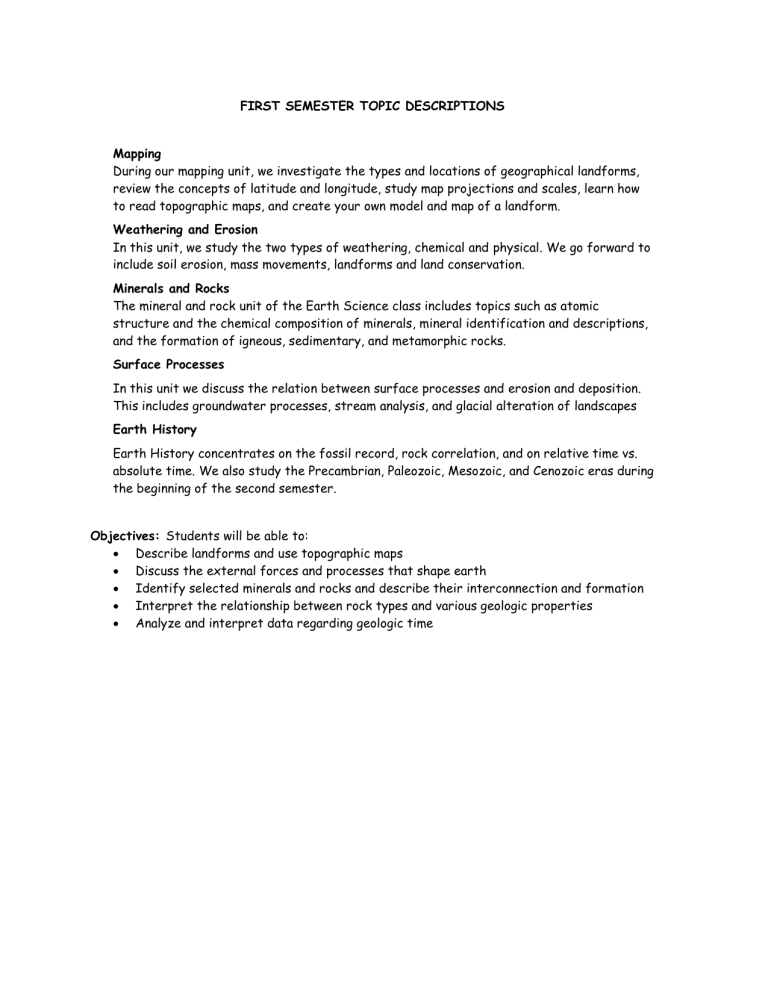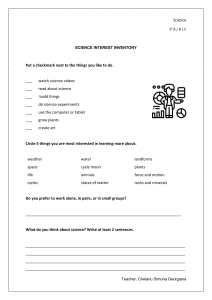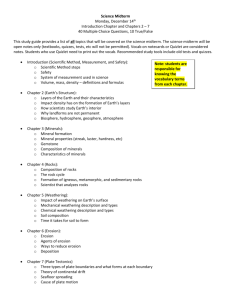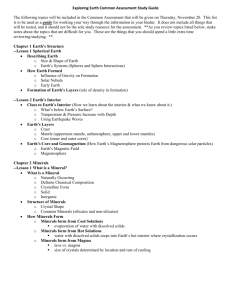- Our Schools

FIRST SEMESTER TOPIC DESCRIPTIONS
Mapping
During our mapping unit, we investigate the types and locations of geographical landforms, review the concepts of latitude and longitude, study map projections and scales, learn how to read topographic maps, and create your own model and map of a landform.
Weathering and Erosion
In this unit, we study the two types of weathering, chemical and physical. We go forward to include soil erosion, mass movements, landforms and land conservation.
Minerals and Rocks
The mineral and rock unit of the Earth Science class includes topics such as atomic structure and the chemical composition of minerals, mineral identification and descriptions, and the formation of igneous, sedimentary, and metamorphic rocks.
Surface Processes
In this unit we discuss the relation between surface processes and erosion and deposition.
This includes groundwater processes, stream analysis, and glacial alteration of landscapes
Earth History
Earth History concentrates on the fossil record, rock correlation, and on relative time vs. absolute time. We also study the Precambrian, Paleozoic, Mesozoic, and Cenozoic eras during the beginning of the second semester.
Objectives: Students will be able to:
Describe landforms and use topographic maps
Discuss the external forces and processes that shape earth
Identify selected minerals and rocks and describe their interconnection and formation
Interpret the relationship between rock types and various geologic properties
Analyze and interpret data regarding geologic time
SECOND SEMESTER TOPIC DESCRIPTIONS
Earth Structure
Plate tectonics is the focus of our Earth Structure unit. We discover evidences for plate tectonics, kinds of plate boundaries, and how this relates to continental growth. This leads us to the study of volcanoes, earthquakes, and mountain building.
Astronomy
Optical astronomy, telescopes, focal length, solar system, planetary movement, earth and moon, inner and outer planets, comets, stars (our sun), galaxies, and space exploration
Meteorology
Atmosphere, radiant energy and heat, air in motion, moisture, evaporation, condensation, dew point, clouds and precipitation, weather systems, frontal weather, cloud formation, air masses, severe weather, weather prediction, analyzing weather reports, climate and geography, climatic changes and climatic models
Oceanography
Information regarding bodies of water, characteristics of ocean water, temperature, salinity and density, waves, currents, tides, mineral energy and water resources, ocean life, pollution, and ocean exploration
Earth and the Environment
Renewable and non-renewable energy resources (water, ores, and fossil fuels), mining methods, conservation of resources (reduce, reuse, recycle) types of pollution and contamination clean up, climate change and the human influence
Objectives: Students will be able to:
Discuss the internal forces and processes that shape earth
Describe the formation and characteristics of planets and stars as well as other planetary and astronomical bodies
Interpret a standard weather map, describe weather processes and phenomena, and recognize the relationship between physical geography and climate zones
Explain ocean properties, sediments and features
Discuss natural resources and how they form, are acquired, and used. Also, interrelate the use and conservation of these resources to their effect on the environment, describing clean-up methods or regulations and how they relate to climate change











